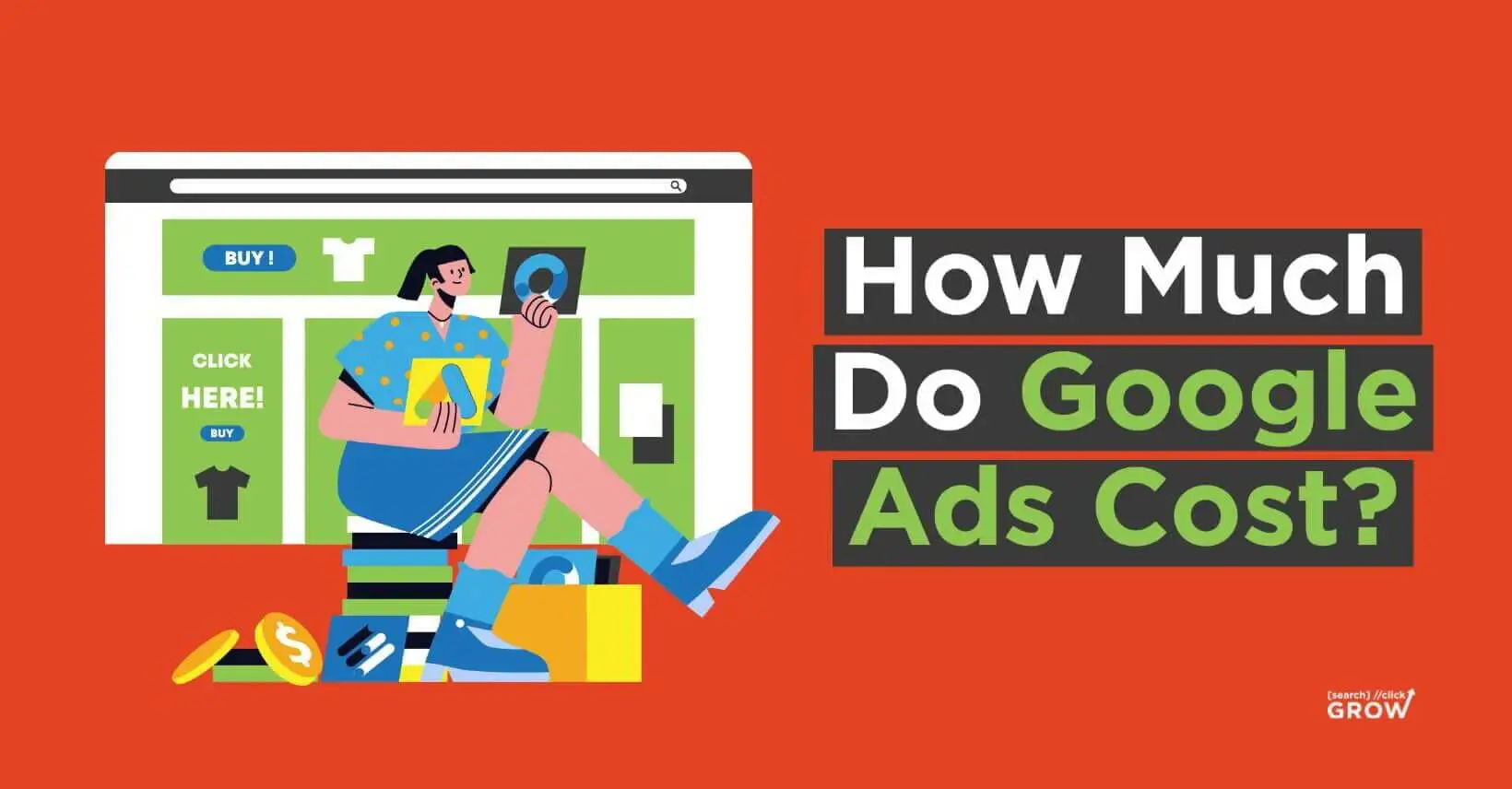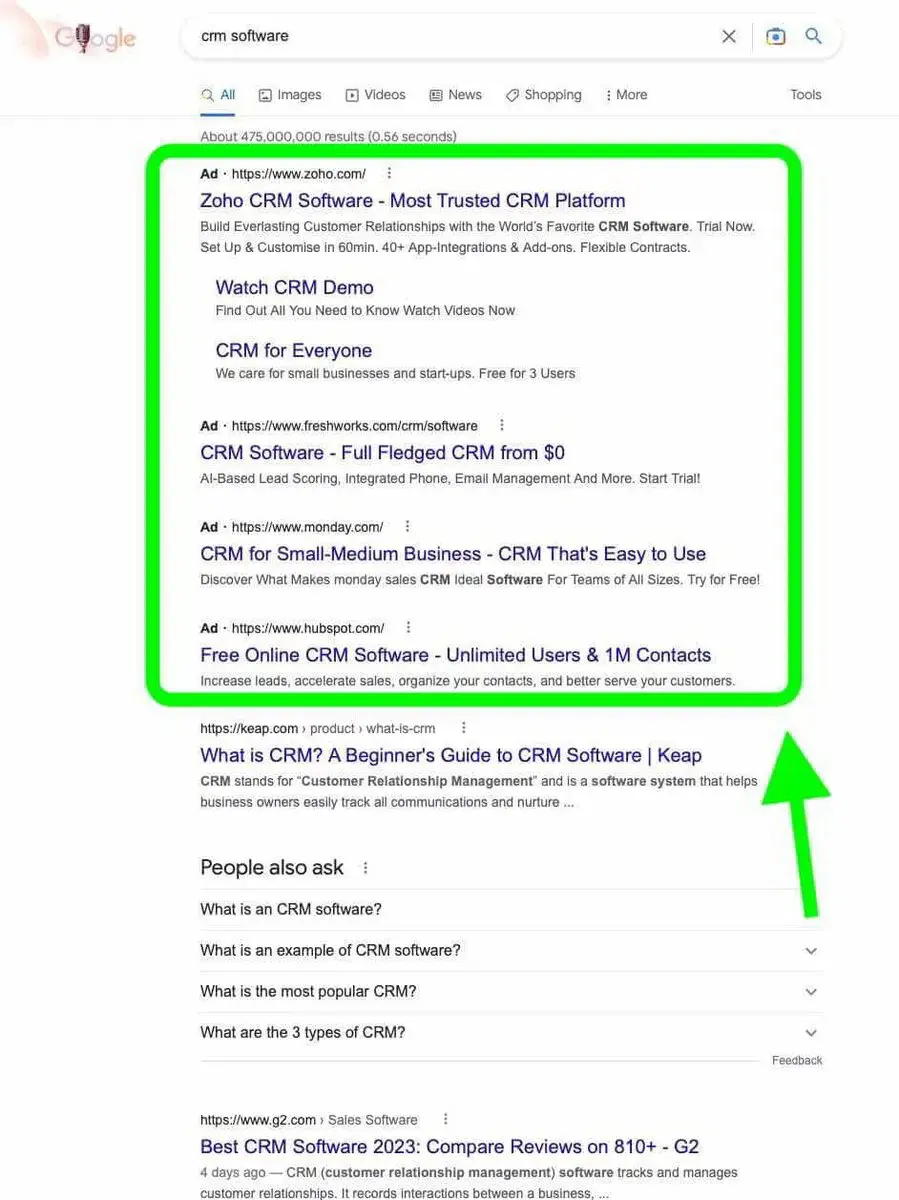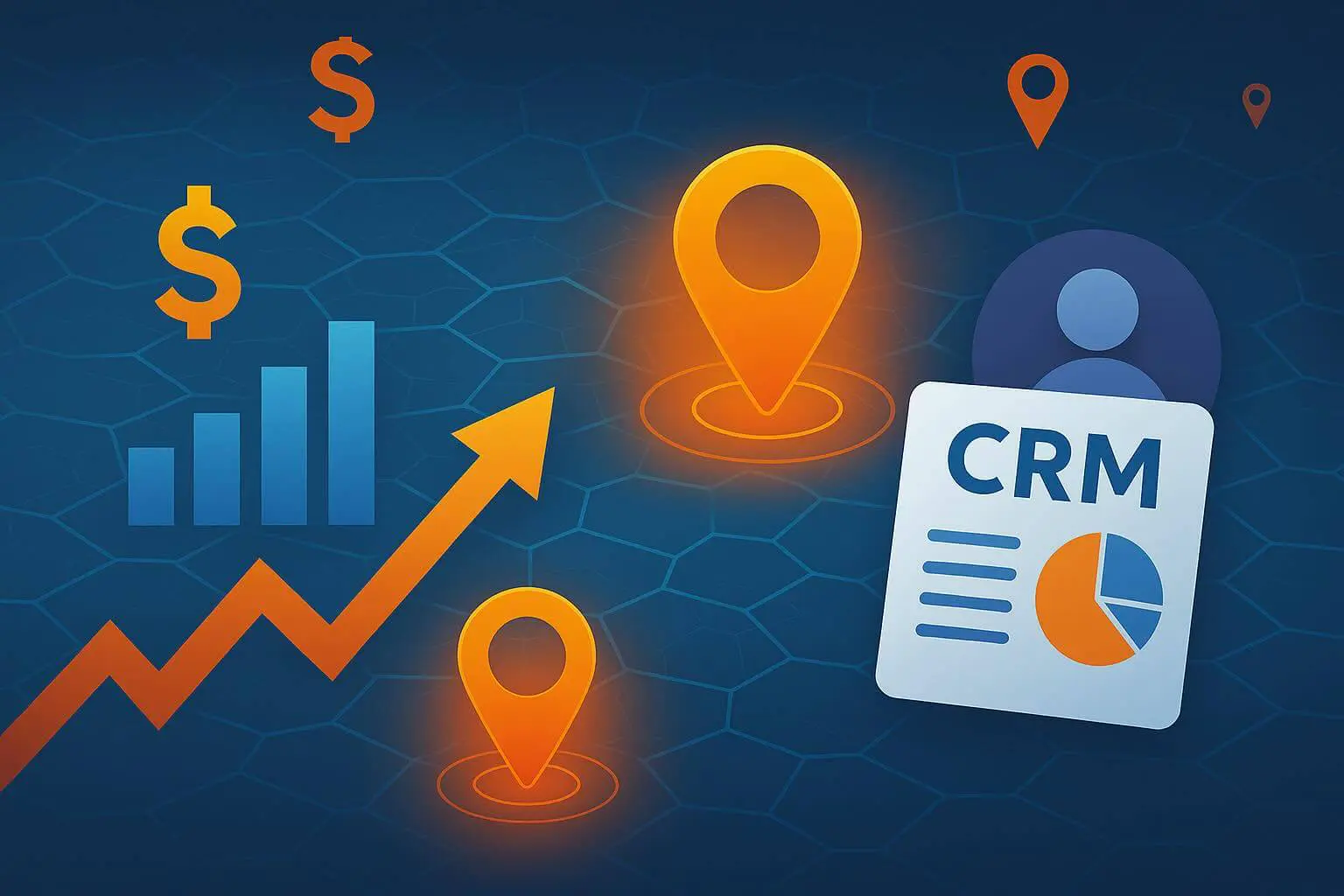
How Much Do Google Ads Cost?
Micha McLain | Posted on |
Reading Time: 8 Minutes
Last Updated on July 11, 2024 by Mafalda Taborda
As we bid farewell to 2022 and hello to 2023, this is a great moment to assess your company’s performance and consider areas where you can improve this year.
New Year’s resolutions might seem like a cheesy tradition, but they’re actually a terrific approach to thinking about the past year and what you want to improve in the new year. One resolution worth considering is maximizing your Google Ads.
To achieve this, you need to learn how much Google Ads cost. Let’s take a closer look.
What Is Google Ads?
Google Ads is Google’s paid online advertising network. Once known as Google Adwords, the search engine giant renamed the service Google Ads in 2018.
Functionally, nothing has changed much:
When users search for a keyword, the results of their inquiry appear on the search engine results page (SERP). Paid advertisements based on the term may also appear in these results.
All the ads are clustered together at the top of Google search results. Except for the big, prominent “Ad” label in the post, they seem almost like regular search engine results.

Since the majority of clicks from Google search results go to the top results, this is good news for marketers.
How Google Ads Work
The model used by Google Ads is known as pay-per-click, or PPC for short. Thus, advertisers aim for a particular Google search term and place bids on it, competing with other marketers who are doing the same.
Your bids represent your absolute maximum offer for that particular ad.
If Google estimates that your cost per click (CPC) is $1.50 and you’ve placed a maximum bid of $3, your ad will be displayed. On the other hand, you will not be granted the ad spot if the CPC is greater than $3.
You can also limit how much money your ad will cost you each day. You can set a daily spending limit on that ad, which will help you better plan the cost of your digital marketing campaign.
The simplest guideline to keep in mind for ongoing campaigns and ad scheduling is this:
You can calculate your maximum monthly cost by multiplying your daily budget by 30.4.
In Google’s system, each month always consists of 30.4 days. If you want to spend no more than $600 on a month-long campaign, you need to allocate no more than $19.74 daily.
Three different bidding options are available to marketers:
- Cost-per-mille (CPM): Amount you have to pay for every 1000 times your ad is seen.
- Cost-per-engagement (CPE): Amount you have to spend per specific ad interaction.
- Cost-per-click (CPC): Amount you have to pay each time one of your ads is clicked.
Benefits of Google Ads
You may be wondering, “Why use Google Ads?” Here are some examples of its many benefits:
Massive Reach
When doing an online search, most individuals first go to Google. With 84.04% of the market share, Google is by far the most popular paid search engine.
In addition to Google’s consistent innovations, this is why companies put money into Google Ads.
It’s a wonderful chance to spread the word about your business and bring in new customers.
High ROI
Investing in Google Ads often pays off for most businesses. To put it another way, for every dollar a company invests in advertisements, it can expect a return of $2.
And if you concentrate on search ads, the figure might rise to $8 for every dollar invested.
Greater Control Over Your Budget
With Google Ads, you can manage your budget with ease.
There is no minimum budget required, and you can set your own spending limits on a monthly, daily, and individual ad basis. You only have to pay if someone clicks or engages with your ad.
Measure Your Performance
When using Google Ads, you can measure exactly how many times your ad has been viewed and clicked on.
You can also see if they did anything else after clicking your ad, like buying something, downloading an app, or calling to place an order.
What Factors Influence Google Ads Pricing?
There is no easy or universal solution when estimating how much your organization will spend on Google Ads.
The cost of Google Ads can change based on several factors, including your industry, current trends, location, competition, device targeting, and more.
Industry
Your industry has the most impact on Google Ads pricing. Higher CPCs are typically associated with more competitive markets in Google Ads; one such market is the business services vertical, which includes industries like law, finance, and real estate.
This is because a single new client can bring in anywhere from $1,000 to $10,000, depending on the nature of your organization, making a CPC of $50 well worth it.
Alternatively, CPCs are lower for companies operating in the arts and entertainment sector. However, they need a great deal more customers to reach the $1,000 to $10,000 goal.
Current Trends
Advertising in the digital space is as dynamic as the ever-shifting landscape of consumer preferences.
It’s vital to be aware of developments in your field and specialty, both intuitively and statistically. This way, you can use it to your advantage.
Location
Most businesses have made their services available worldwide, which means they run various advertising campaigns in different countries.
This means that consumers in various parts of the world will use the internet with varying goals in mind.
As a result, the average CPC for Google Ads varies among regions.
Competition
Google ad prices vary widely according to levels of competition. Your bid strategy, ad position, click-through rate (CTR), and CPC will all be affected by the level of competition in the market.
If, for instance, two companies are both bidding for the top spot in a Google Search, the CPC will rise as they attempt to outbid each other. In the same way, the CPC can go up during the holidays when many advertisers are vying for the same set of in-demand search terms.
Device Targeting
Back in the day, most internet searches were done on desktop browsers. Then along came the smartphone revolution.
Statista reports that 86.41% of people around the globe have access to a smartphone. This suggests that people are shifting their search habits from desktop computers to mobile devices.
As the number of people using mobile devices continues to rise, a larger percentage of your marketing spend will naturally be allocated to this growing sector. If your ads are shown on the right device, you can save money and increase reach.
Consequently, this opens the door to more conversions.
How Does Google Calculate Your CPC?
One of the best things about Google Ads is that even though it functions as an auction, those who win aren’t determined only by bid, and you aren’t always charged the maximum amount you’ve bid.
Let’s quickly go over how Google Ads chooses its winners and sets its CPCs.
Quality Score
Google checks to see if any marketers have bid on terms related to a user’s search query. If so, Google will start an auction and include all relevant ads.
Before deciding on a winner, it gives each advertisement a Quality Score. Scores range from 1 to 10 and are based on several factors, including the quality of the ad and landing page in relation to the keyword, the predicted click-through rate, and the quality of the landing page itself.
Ad Rank
The Ad Rank that Google assigns to each competing ad ultimately determines whether your ad appears in the area for paid search results.
Your Ad Rank is calculated by multiplying your Quality Score with your maximum bid.
Max Bid
The only time you’ll have to shell out cash is if a potential customer actually clicks on your ad after seeing it. However, as we said, you do not always pay the maximum bid.
Calculating your cost-per-click with Google Ads is as follows:
The Ad Rank of the advertisement that is just below yours, divided by your own Quality Score, then add one cent.
Because of this formula, a business that offers lower bids than its competitors might rank higher on the search engine results page thanks to a higher Quality Score.
Because of this, even if you have a small advertising budget, you can still compete successfully on Google.
Controlling Google Ads Cost With Keywords
Maintaining a low CPC is a primary goal when using Google ads. By doing so, you can rest assured that your efforts will yield a positive return on ad spend (ROAS).
When working to reduce your CPC, one of the first things you should examine is the terms you’re bidding on.
“Long tail keywords” refer to search phrases of four words or more. In general, the bidding competition for long-tail keywords is lower because there is a lower volume of searches associated with them.
Thus, they are typically more affordable than their more general, shorter keyword equivalents. Your keyword bidding strategy must focus on the correct terms to maximize profits.
How to Figure Out Google Ads ROAS
ROAS is the percentage increase in sales expected for each dollar spent on marketing. The higher the return, the more influential the ad campaign.
The initial step in calculating the returns from your Google ads is to have a firm grasp of your company’s metrics.
Some of the crucial metrics are as follows:
- Conversion rate: In addition to tracking leads, this metric tracks how many of those leads resulted in purchases. By tracking conversion rates across paid, social, organic, and other channels, you can rapidly determine which strategies produce the best results and devote more resources accordingly. Measuring conversions is far more helpful than tracking total traffic statistics.
- Lead close rate: Even if many purchases are made offline, you need to incorporate those figures into your analytics to see how effectively you guide customers through the sales journey. Checking your lead close rate can help you spot marketing issues. If you’re getting a lot of leads but not many conversions, it’s possible you’re not attracting quality leads.
- Cost Per Acquisition (CPA): The CPA is a valuable metric for guiding sales efforts in the right direction.
These metrics can help you evaluate your Google Ad spend. To make things easier, we have a Google Ads ROAS calculator that can help you estimate your ROAS
How to Calculate Your Google Ads Budget
Although it can be daunting to try and calculate and determine a successful Google Ads budget, a well-planned one is a crucial factor in the effectiveness of your PPC campaigns.
Some marketers will not stop spending until they reach a monthly goal, while for others, budgets are determined solely by revenue.
If you have a specific Google Ads budget, one of the smartest things you can do is prioritize making the most profit possible within that limit.
You need to understand the fundamentals of your company to develop a budget strategy geared toward maximizing profits.
Budget Estimate
To begin, you need to create a starting budget that reflects the amount of money you are willing to spend every month.
Additionally, you should ensure that it complies with your business’s expectations.
After launching your campaign, you can fine-tune this estimate based on the data you collect from actual customers.
Average CPC
The Google Keyword Planner is an excellent tool for calculating potential CPCs.
Consider these projections as ballpark figures to work with, and feel free to tweak them based on the success or failure of previous advertising campaigns.
Just type a search term you’re considering using for ads into Google Keyword Planner’s “product or service” field to get rough cost estimates. After entering a search phrase, Google’s Keyword Planner will provide recommendations for relevant keywords.
The figure in the “Suggested Bids” column can serve as a fair estimate of your CPC. The CPC you ultimately pay will vary from the budget you initially set, so monitoring the two closely together is essential.
Wrapping Up: How Much Do Google Ads Cost?
As we’ve said all along, many factors can affect the cost of running a Google Ads campaign.
You can influence some factors, like quality scores, keywords, and metrics, while others, like competition and CPC, are out of your hands.
At the end of the day, your Google Ads budget is entirely up to you. However you decide to use it, Google Ads is a fantastic tool for virtually any company!
Contact us today to learn more about advertising on Google.
Micha McLain
Related Posts
-

Micha McLain | Posted on |
How to Use CRM Zip Code Targeting to Maximize Your Ad ROIReading Time: 18 Minutes
Last Updated on April 10, 2025 by Mafalda Taborda
-

Micha McLain | Posted on |
Mastering the 5 Stages of the Customer Journey for ContractorsReading Time: 17 Minutes
-

Micha McLain | Posted on |
How to Build a High-Converting Website: The MENU FrameworkReading Time: 10 Minutes
Last Updated on February 27, 2025 by Mafalda Taborda






